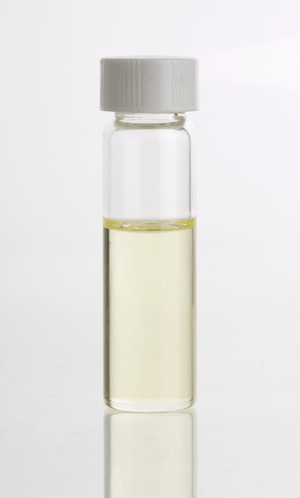Sandalwood oil facts for kids
Sandalwood oil is a special essential oil that comes from sandalwood trees. It's made by a process called steam distillation. This means steam is used to get the oil out of small pieces of the tree's heartwood (the inner part of the wood). The main types of trees used are Santalum album (Indian sandalwood) and Santalum spicatum (Australian sandalwood).
People use sandalwood oil in many ways. It's found in perfumes and cosmetics like lotions and soaps. It's also used in sacred oils for religious ceremonies. Sometimes, a tiny bit is even used to add a mild flavor to food.
Contents
What's Inside Sandalwood Oil?
Sandalwood oil is mostly made of special chemicals called alcohols. More than 90% of the oil is made of these alcohols. The most important ones are called alpha-santalol (about 50-60%) and beta-santalol (about 20-25%). These are the chemicals that give sandalwood oil its unique smell.
The exact mix of these chemicals can change. It depends on the type of sandalwood tree, where it grew, how old the tree was, and even when it was harvested. The way the oil is taken out of the wood also makes a difference.
How People Use Sandalwood Oil
Sandalwood oil has a wonderful smell, which is why it's so popular. It's often used in aromatherapy, where people use scents to help them relax or feel better. You can also find it in many soaps and beauty products.
In Ayurvedic medicine, an ancient healing system from India, sandalwood oil is used for various health issues. People have used it for common colds, coughs, fevers, and even infections in the body. Some studies have shown that just smelling sandalwood oil can affect your body, like making your heart beat a bit faster.
Sandalwood oil is also very important in many religions around the world. It's used in Hinduism, Jainism, Buddhism, and Zoroastrianism for different rituals and ceremonies.
Making Sandalwood Oil
To get the oil, the wood from the whole tree is used, including the stump and roots. For Australian sandalwood (S. spicatum), the white outer part of the wood, called sapwood, can stay on. But for Indian sandalwood (S. album), the sapwood needs to be removed before the oil is made.
The Scent of Sandalwood
Sandalwood oil is loved for its warm, woody, and slightly sweet smell. It mixes well with other scents like violet, rose, and clove. Because real sandalwood wood is rare and expensive, companies sometimes try to create artificial smells that are similar to sandalwood.
Scientists have made several artificial scents that smell like sandalwood oil. These are often used in perfumes and skin products because they cost less. Some of these artificial scents are called Sandalore and Brahmanol. Interestingly, some of these artificial scents have been found to help with things like wound healing, even more than natural sandalwood oil!
Is Sandalwood Oil Safe?
There hasn't been a lot of detailed research on how safe sandalwood oil is. However, there haven't been many serious problems reported when people use it. This is why it's still used in beauty products and as a food flavoring. A few studies have looked into whether it could be harmful, but they found that it's safe when used in the small amounts typically found in food.
See also
 In Spanish: Aceite de madera de sándalo para niños
In Spanish: Aceite de madera de sándalo para niños


